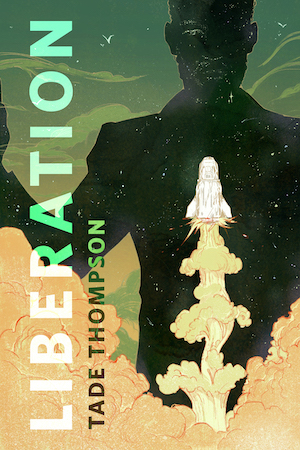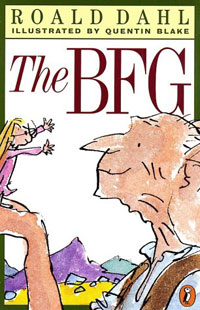Sophie, an orphan, is suffering a major attack of insomnia, brought on, author Roald Dahl suggests, by the magic of moonlight, or perhaps by the fact that she’s living in a dormitory and has lost her parents, when she catches sight of a long dark shadow. It is, as she soon discovers to her terror, the shadow of a giant—a giant with the power to capture dreams and nightmares and bring them to children. And a giant who is initially not at all pleased to be spotted by a child, since the entire point of giant life is not to be seen by humans—or as the giants call them, “Human Beans.” Especially because most giants survive by eating humans, a diet that works only if humans know nothing about them.
This particular giant, however, is just a little different. He is the Big Friendly Giant, or The BFG, refusing to eat humans. So instead of following his biological destiny and eating Sophie, he takes her from the orphanage to the land of giants and dreams.
Roald Dahl had already devoted a chapter to the Big Friendly Giant in his earlier book, Danny, the Champion of the World. In this book, he fleshes out the details told there: the way the giant catches dreams, descriptions of the particular dreams, rather more disgusting descriptions of giant food (yuck yuck—no wonder they eat humans), the way giants don’t have to sleep very much, but how deeply they sleep when they do. Dahl also sketches in the other giants, all horrible monstrous stuff with horribly monstrous names, who, when not eating humans, like to harass—which means toss into the sky—the Big Friendly Giant. It’s a rather nasty sequence, and it convinces Sophie that humans must be saved from the giants.
Aside: Unlike the book, I am taking the time to type out Big Friendly Giant instead of using BFG for short, since another word entirely for the letter “F” kept coming to mind while I was reading the book, which I found fairly distracting.
The giants’ command of English is questionable, to say the least, causing some communication problems with Sophie, who is young enough to be pretty tactless about it. As the Big Friendly Giant explains, in somewhat hurt tones, he has never had a chance to go to school and learn proper English, and his only exposure to books has come from a single copy of Charles Dickens’s Nicholas Nickleby, not exactly a book good for eliminating all issues with the English language, or for convincing giants that humans are worth saving. It takes Sophie to convince him otherwise—and to come up with a plan for saving humanity—and specifically, kids in dorms—from the giants.
As with all of Dahl’s work, the book swings from silliness to deeper moments. Some of these deeper moments are quite explicit, as when the Big Friendly Giant reminds Sophie that for all of the moral failures of the giants, human beings are not all that much better. Sure, giants may be eating humans, but humans are actually killing other humans, and far more of them, sometimes using aeroplanes and bombs. Dahl’s World War II memories seem to be slipping through here.
The deeper parts of the dreams collected by the giant contain more subtle moments. These dreams for children—which the giant carefully notes down in his not particularly grammatical English—are meant to be lighthearted, but even the happiest dreams showcase the terrors and fears of small children, and a particular subset of small children: those who believe that adults do not take them seriously. (Or maybe less a subset and more all children.) Again and again, the dreams show children proving their intelligence and capability to adults, only to be woken back into a world where adults do not take them seriously. It’s not at all surprising, then, to find that in order to stop the giants from eating more humans, Sophie must prove her own intelligence and capability to adults—and uses dreams to do so.
For all of his evident sympathy for misunderstood children, based on the book’s last few sentences, Dahl apparently identified more with the giant, perhaps suggesting that Dahl saw himself as a recorder of children’s dreams. Like Dahl, the giant is a storyteller; they both have a strong fondness for Charles Dickens; they both use made up words that have never before appeared in English. Both have a fairly negative view of human society (although I think we can argue that Dahl’s attitude was even more negative than the giant’s); both find it easier at times to talk to children than adults. And both take pride in catching and transporting the dreams of children.
Dahl also slips some of his political opinions in here and there—the U.S. president, who appears only in dreams, appears to be fairly incompetent; Queen Elizabeth II, who appears in reality, is competent and improbably powerful. (I mean no disrespect to the British monarchy, but Dahl is either really playing up to his young readers here, or he has a lot more faith in the power and influence of Elizabeth II than I have, even with her recent helicopter jump into the Olympics.) Her household staff, however, far more probably, is exquisitely trained and competent, and if you are wondering how to entertain a giant in your own household palace, this book is the guide for you.
Parents and readers should be warned: the second chapter of this book makes various jokes about and puns on country names and ethnicities that many readers will find offensive or simply not funny (the puns are distinctly aimed at a six year old level.) And although I can see that this could make the book more entertaining, I found most of the giant’s misused words and bad spelling fairly wearisome. This is a book that I think works distinctly better for children than for adults, which may not be entirely a bad thing.
Mari Ness took notes on the care and feeding of giants, just in case, even though they seem to be rare on the ground in her home in central Florida.











The BFG is my favourite Roald Dahl book, bar Matilda (I taught myself to read at three years old by picking out all the ‘Matilda’s through the book, followed by all the ‘Miss Honey’s’, so Dahl and his wit are deep in my literary marrow).
I love the dreams: as you note, they always seemed so real to me when I read this book as a child — they proved over and over again that children were cool and clever and did things! And then they woke up.
In a way I think the BFG, and most of his other books, are Dahl’s way of not waking up into the world, and that wistfulness is reflected in the BFG’s loneliness, his reading material, and Sophie’s entire character. I always felt this was a book about loneliness, and being alone, and I loved it for that.
I never read the book, but I remember loving the BFG movie when I was a kid.
in the book